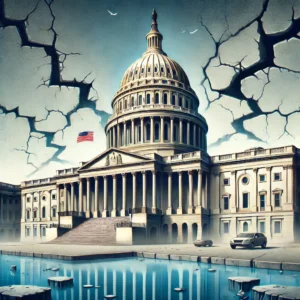America on the Brink: The Consequences and Realities of a U.S. Default

The United States has long been regarded as a pillar of economic stability, with its debt instruments considered among the safest investments globally. However, the concept of a U.S. default—where the government fails to meet its debt obligations—has periodically emerged as a topic of concern, particularly during debates over the debt ceiling. Understanding the implications of such a default requires a comprehensive examination of the debt ceiling’s history, the potential consequences of breaching it, and the broader economic ramifications.

Understanding the Debt Ceiling
The debt ceiling is a statutory limit set by Congress on the total amount of money the federal government is authorized to borrow to meet its existing legal obligations. These obligations include funding for social programs like Social Security and Medicare, military salaries, interest on the national debt, tax refunds, and other expenditures. As of early 2025, the debt ceiling stands at approximately $36.1 trillion.
The primary purpose of the debt ceiling is to control government borrowing and ensure fiscal responsibility. However, it does not restrict Congress’s ability to enact spending and tax laws that affect the federal deficit. Instead, it limits the Treasury’s ability to pay for expenditures that have already been approved by Congress and the President. This creates a situation where the government must periodically seek congressional approval to raise or suspend the debt limit to avoid defaulting on its obligations.
Historical Context of Debt Ceiling Crises
The United States has faced several debt ceiling crises in recent decades, each highlighting the potential risks associated with approaching or breaching the debt limit.

- 2011 Debt Ceiling Crisis: In 2011, a standoff between Congress and the Obama administration over raising the debt ceiling led to significant market volatility. The crisis was resolved just days before the projected default date, but not before Standard & Poor’s downgraded the U.S. credit rating from AAA to AA+, citing political brinkmanship and concerns about the government’s ability to manage its finances.
- 2023 Debt Ceiling Crisis: A similar impasse occurred in 2023, with debates over spending cuts and fiscal policy leading to concerns about a potential default. The crisis was ultimately averted through bipartisan negotiations, but it underscored the recurring nature of debt ceiling disputes and their implications for economic stability.
Potential Consequences of a U.S. Default
A default by the United States government would have far-reaching and potentially catastrophic consequences for both domestic and global economies.
- Financial Market Turmoil: U.S. Treasury securities are considered the benchmark for risk-free assets worldwide. A default would undermine this perception, leading to increased volatility in global financial markets. Investors might demand higher yields on U.S. debt to compensate for perceived risk, resulting in increased borrowing costs for the government.
- Economic Recession: The uncertainty stemming from a default could erode consumer and business confidence, leading to reduced spending and investment. This contraction in economic activity could trigger a recession, with rising unemployment and decreased economic output.
- Impact on Government Services: In the event of a default, the government would be unable to meet all its financial obligations. This could result in delays or suspensions of payments for federal programs, including Social Security, Medicare, and military salaries, adversely affecting millions of Americans who rely on these services.
- Global Economic Implications: Given the central role of the U.S. dollar and Treasury securities in the global financial system, a U.S. default could lead to a loss of confidence in dollar-denominated assets. This could prompt foreign investors to reduce their holdings of U.S. debt, leading to further increases in interest rates and potential disruptions in global trade and investment flows.
Mechanisms to Prevent Default
To avert the severe consequences of a default, the U.S. government has several mechanisms at its disposal:

- Raising or Suspending the Debt Ceiling: The most straightforward approach is for Congress to pass legislation that raises or suspends the debt ceiling, allowing the Treasury to continue borrowing to meet existing obligations. This has been the traditional method employed in past debt ceiling crises.
- Extraordinary Measures: In situations where the debt ceiling has been reached, the Treasury can implement “extraordinary measures” to temporarily free up cash and extend the time before a default occurs. These measures include suspending investments in certain federal accounts and redeeming existing investments. However, these are temporary solutions and do not address the underlying need to increase the debt limit.
- Prioritization of Payments: Some policymakers have suggested that the Treasury could prioritize certain payments, such as interest on the debt, to avoid a formal default. However, the Treasury has argued that all obligations are legally on equal footing, making prioritization challenging and legally questionable.
- Invoking the 14th Amendment: Some legal scholars argue that the 14th Amendment, which states that “the validity of the public debt of the United States…shall not be questioned,” could be invoked to bypass the debt ceiling. However, this approach is unprecedented and could lead to legal challenges and further uncertainty.
Recent Developments and Future Outlook

As of early 2025, the United States once again faces the prospect of reaching its debt ceiling. The Treasury Department has already begun implementing extraordinary measures to prevent a default, but these measures are only temporary. The exact timeline, often referred to as the “X-Date,” when the government will no longer be able to meet its
